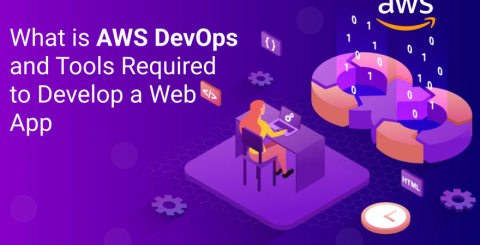What is AWS DevOps and Tools Required to Develop a Web App

As technology advances, businesses are continuously seeking methods to simplify their processes and boost efficiency. Implementing DevOps practices is one way to do this, and with the popularity of cloud computing, AWS (Amazon Web Services) DevOps has emerged as a popular option for many businesses. AWS Development Services refer to the many tools and resources provided by Amazon Web Services (AWS) to assist developers in designing, launching, and managing cloud-based applications. Cloud Development Services, on the other hand, are focused on developing apps expressly for the cloud. This involves developing cloud-native apps, leveraging cloud-based resources such as databases and storage, and employing container orchestration technologies such as Kubernetes.
AWS DevOps integrates these two domains to offer a holistic approach to building and delivering cloud-based applications. Developers can quickly and simply build and test their applications with Amazon Development Services, while Cloud Development Services can provide a framework for deploying and managing them in a scalable and effective manner. One of the main advantages of AWS DevOps is its capacity to automate a large number of the repetitive operations required in software development and deployment. Developers may now concentrate on more crucial activities, including creating new features and enhancing the user experience while also saving time and lowering the likelihood of mistakes.
According to a survey conducted by DevOps Research and Assessment (DORA), organizations that utilize Amazon DevOps services like AWS CodePipeline, AWS CodeDeploy, and AWS CloudFormation, etc. are more likely to have high-performing DevOps teams. In comparison to underperforming teams, these teams release code more frequently, with fewer mistakes, and quickly after failures.
AWS DevOps: How Does It Work?
AWS DevOps is Amazon's strategy for implementing the DevOps mindset and practices side by side on its cloud platform, together with a set of tools and military equipment created for that goal. You may deploy application code, automate software release procedures, set up and manage communications, and monitor the performance of your infrastructure and applications using these services. It enables businesses to create and deliver products more rapidly and dependably using AWS and DevOps techniques. They can automatically create, test, and deploy apps thanks to the program, as well as save and update application source code safely. AWS services assist you in implementing DevOps in your organization. These services were designed to integrate with AWS. These tools assist the developers of AWS Development and Cloud Development Services in managing complicated settings on a wide scale while also keeping software developers in control of DevOps' quick pace.
DevOps Tools Required Developing a Web App
DevOps tools from AWS allow the operations team and development team to work together and automate procedures like continuous integration, delivery, and deployment. These technologies give developers the ability to swiftly and effectively create and deploy web applications while preserving the consistency and dependability of the software. Following are some of the most popular AWS DevOps tools required for developing a web application:
- Amazon CodeCommit: A completely managed source control solution that streamlines team collaboration on code, change tracking, and version management.
- Amazon CodeBuild: A completely managed build service that builds code from scratch, does tests and creates artifacts that are ready for deployment.
- AWS CodePipeline: The construction, testing, and deployment of code updates are all automated using AWS CodePipeline, a fully managed continuous delivery service. Rolling and blue/green deployments are only two of the many third-party tools and services that it can interact with. It also supports a variety of deployment methodologies.
- AWS Elastic Beanstalk: Developers can install and maintain web applications using the fully managed service known as AWS Elastic Beanstalk in a highly scalable and fault-tolerant environment. It may be used to rapidly and simply deploy web apps and supports a variety of programming languages and platforms.
- AWS CloudFormation: Developers may specify and deploy infrastructure as code using AWS CloudFormation, a fully managed service. It is used to automatically create and maintain intricate infrastructure settings and to support several AWS services and resources.
Top AWS DevOps Practices
When combining AWS with DevOps, keep the following best practices in mind:
- Monitoring and Logging: To ensure events are triggered at the appropriate moment. It is possible to handle many underperforming activities at once.
- Infrastructure Automation: It emphasizes producing high-quality code and automated testing at frequent intervals.
- Continuous Delivery and Continuous Integration: CI/CD philosophy supports DevOps by constructing and validating projects, while continuous delivery automatically deploys code.
- Infrastructure as Code: The AWS cloud services are deployed and maintained by writing a machine and human-readable template file.
- Communication and Collaboration: Adopt the ownership and accountability-focused DevOps culture. Teams from development and operations work closely and collaboratively, divide tasks, and merge workflows.
Excellent Amazon DevOps Case Studies
Several organizations have utilized these above-mentioned AWS DevOps tools to efficiently create and deploy web applications.
- Airbnb: A worldwide vacation rental marketplace, for example, was able to minimize the time it needed to deploy changes from an average of 30-60 minutes to only 3-5 minutes with the help of AWS CodeDeploy.
- Netflix: A renowned streaming service that leverages AWS DevOps technologies to quickly and efficiently deploy new features and changes to its streaming service, allowing it to respond to user input and remains ahead of the competition.
- Tata Motors: It’s India's largest automobile manufacturer that used AWS DevOps tools to transform its software delivery process, reducing application deployment time, release frequency, and infrastructure costs by 30%.
- GE Healthcare: A leading provider of medical imaging and information technologies that leveraged AWS DevOps tools to reduce software deployment time, increase release frequency, and improve software quality and customer satisfaction.
- Zynga: An online gaming platform that uses AWS CodePipeline to reduce the time it takes to release updates allowing them to quickly respond to market demands and stay competitive in the fast-paced gaming industry.
Wrapping up
DevOps and AWS are both growing in popularity, so it is important to have knowledge of both to stay up-to-date. With AWS Development Services developers can take their productivity and workflows to the next level by creating, deploying, and managing applications more efficiently and effectively than ever before. AWS DevOps and AWS DevOps Tools will continue to be crucial in the creation and delivery of greater software applications as businesses adopt cloud-based technologies at an increasing rate.
Similar Articles
Not long ago, the idea of multiple AI agents working together, each with a specific role, collaborating to solve problems, felt like science fiction.
In today’s data-driven world, choosing the right business intelligence (BI) platform can make or break your organization's analytics success.
We all know that companies today are no longer limited to a single physical location. Work processes are also no longer strictly isolated.
It is neither secret nor news that the mind-boggling pace of digital transformation around us has totally altered consumer expectations.
In the world of finance, speed and accuracy are everything. Decisions made a day late can cost millions, and delayed visibility into financial performance can leave even the best organizations blind to risks.
Discover the best tools to enhance employee recognition, boost morale, and create a more motivated, engaged workplace culture.
At first glance, off-the-shelf software appears to be a dream come true. They are quick to set up, cheaper upfront, and marketed as “universal.”
A modern business must continually adapt. This bit everyone seems to know.
The modern healthcare industry is undergoing a significant transformation. The models of healthcare that we are used to thus far are now making way for a more data driven approach









